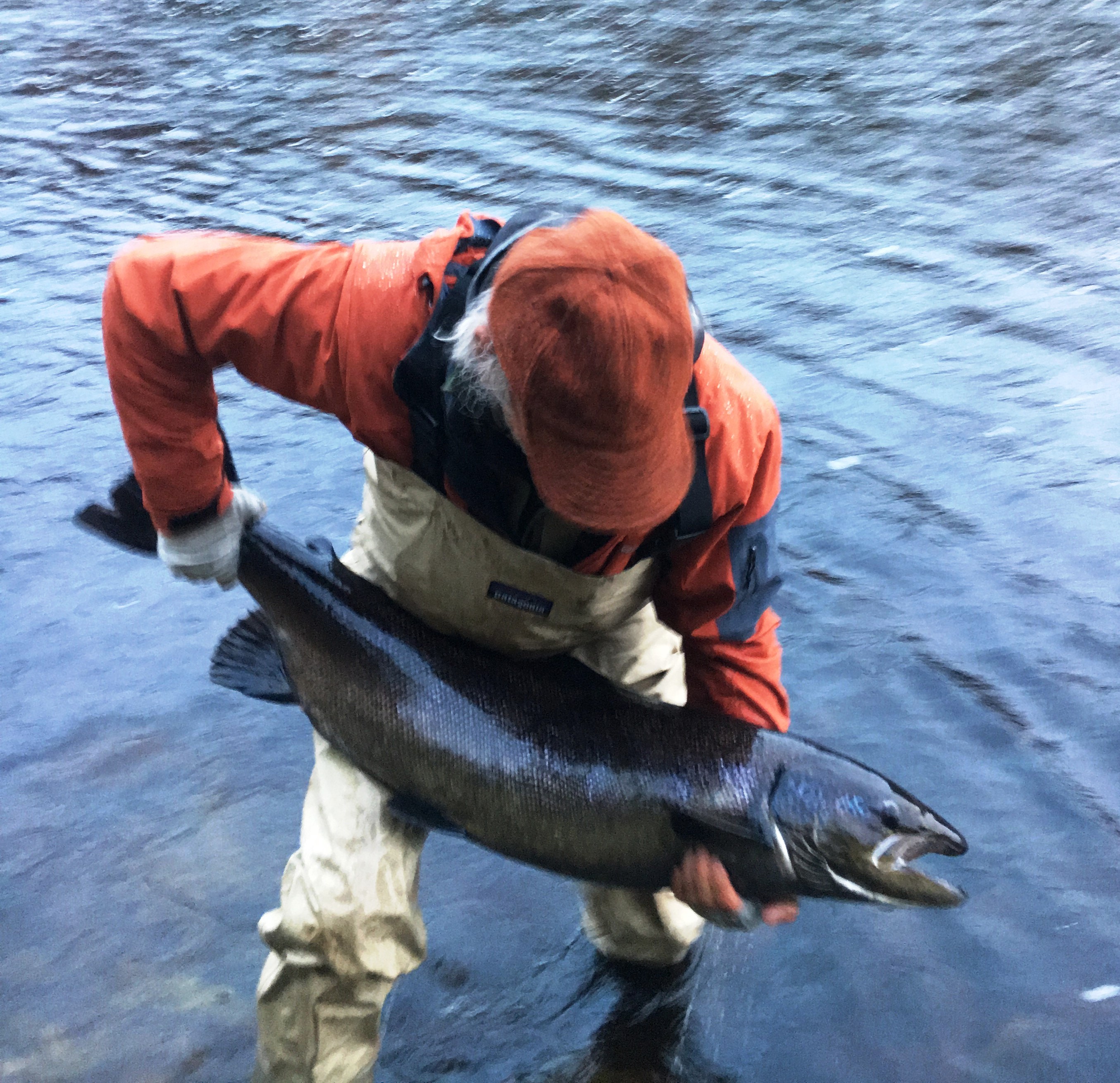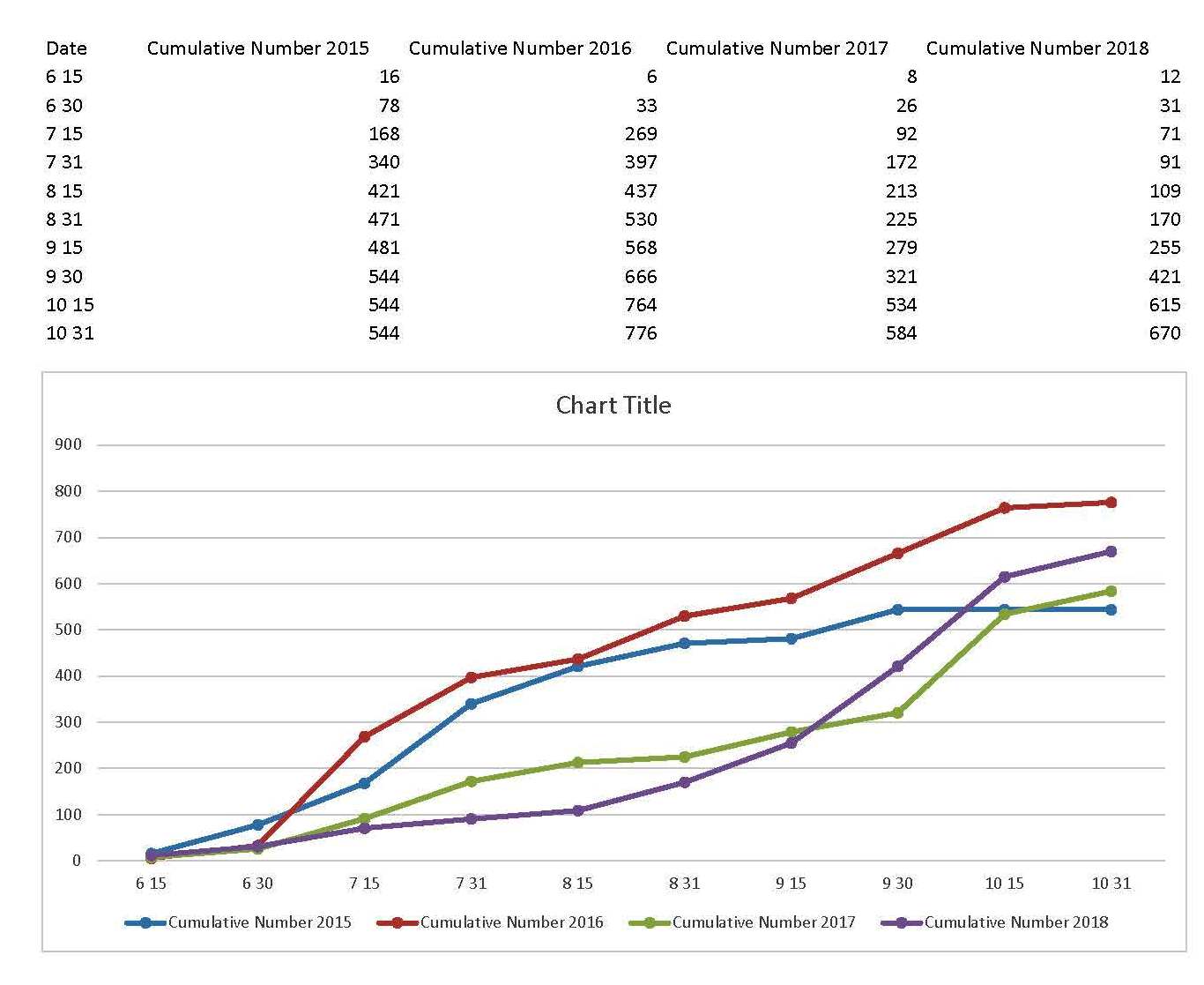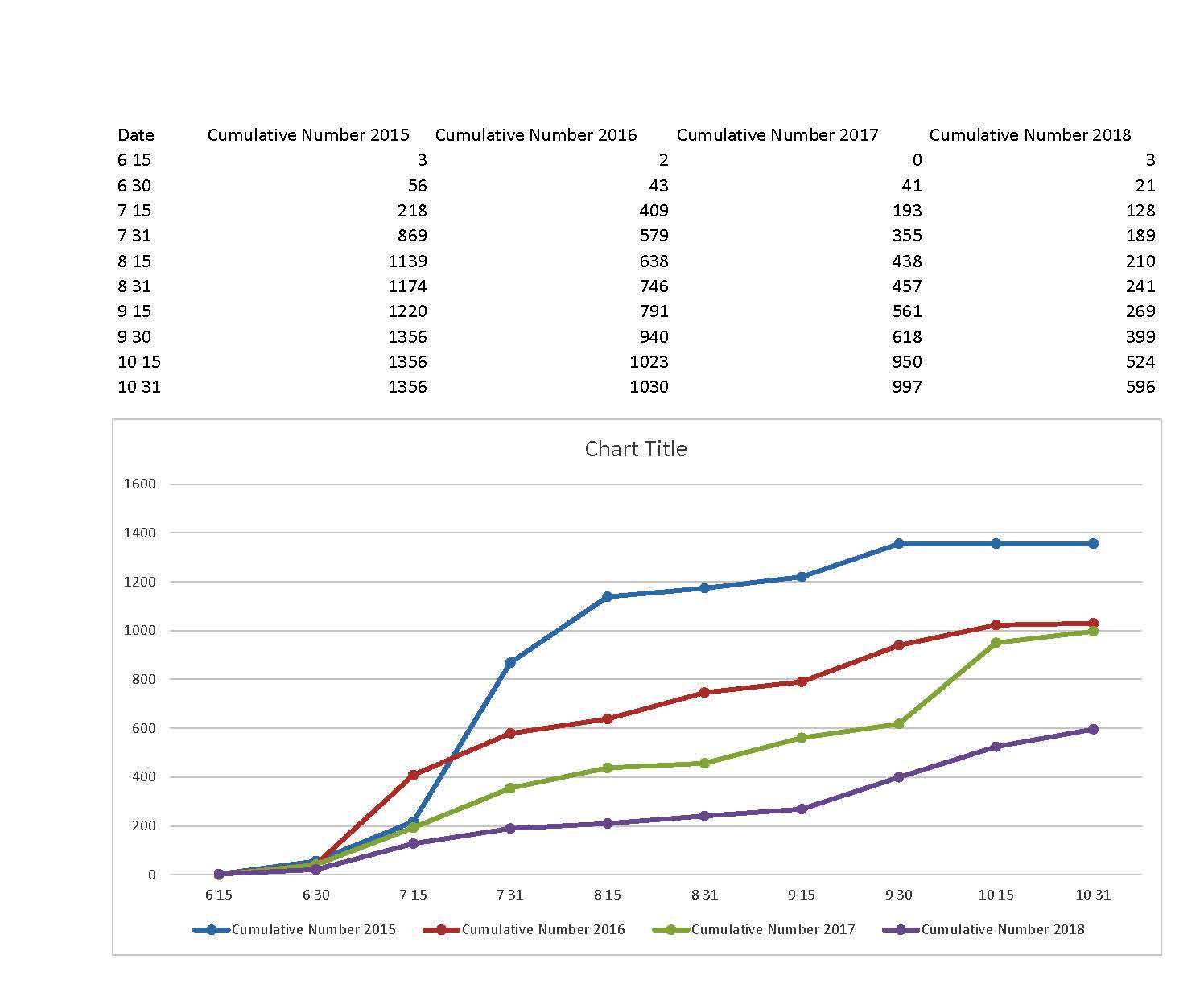
Miramichi River Year End Millerton Trap Numbers Analysis

This humungous hen salmon was caught and released 20 miles up the Cains in the last few hours of the season. There were a good number of fish quietly pushing up the river that last week, and with the decent returns of large salmon we can hope for a good year of spawning.
The Department of Fisheries and Oceans “DFO” salmon counting trap at Millerton on the Southwest Miramichi River is finished reporting for the year. I have put together a spread sheet below that has the number of grilse on one tab and salmon on another for each of the bi-weekly reporting dates throughout the season. I have also charted the counts throughout the season.
I’m not a biologist, nor am I someone who has worked closely with these numbers over a long period of years. I’m sure we’ll hear some analysis from some of these people as time goes along. What these numbers actually mean can be simple, and yet the information can also be complicated as it may indicate future trends that aren’t at all obvious. A couple of things that I have definitely learned, and that is that there is a fair amount of disagreement even among the experts as to what some of these numbers mean, and why they are occurring. Also, I have learned that DFO takes a fairly long term view of the numbers, and no one there is reacting any too quickly to whatever the news may be. That can be good as the general trend in the United States is for fishery officials to increase harvest on the hint of good news, and drag their feet when it comes reducing harvest levels. It can also be bad as the wait and see attitude can take you to a point where corrective actions eventually need to be much more draconian than would have been necessary initially.
- First, the number of large salmon in 2018 was 670 which is the highest in the last three years, and only 15% below the average year from 1995 through 2014 – a period of seemingly good times compared to the last few years. The long term efficiency of the Millerton trap on salmon is roughly 5%, so 670 amounts to about 13,400 fish. All things considered this is not a bad number, and it does not include the NW Branch nor does it include grilse, just salmon larger than 25 inches in the Southwest Miramichi. There were many years in the last 30 when large salmon counts were much lower than they were in 2018.
- Grilse numbers, however, fell through the floor. At 596 it is the lowest number that I could find in the history of the fishery. In the 90s and early 2000s grilse counts were often 2,500 or more. Clearly salmon are having a worse time in the ocean during their first year at sea than their second. Well-known, DFO biologist Bill Hooper told me that the conservation organizations need to concentrate on finding out what is killing so many grilse during their first months in the ocean. Certainly in the Miramichi striped bass must play a big part, and no other river seems to have seen the recent decline in grilse runs that the Miramichi has.
- The grilse numbers also often foretell next year’s salmon numbers since the majority of the salmon run are two year old females that were the sisters of the grilse that returned after one year at sea. If an inordinate number of the males died during that first year at sea it is likely to be similar for the females. Historically the correlation has been there, though it is not always the case. We’ll have to wait and see on that one, but a record low grilse number is not a positive sign.
- It is also true that the trend of poorer salmon returns based around lower grilse returns didn’t start this year. Mark Hambrook pointed out to me in September that the number of 2 MSW salmon in the Dungarvon barrier count this year is much lower as a percentage of the total than has historically been the case. In other words salmon counts are being buoyed up a bit by larger, older, repeat spawners. Without new recruits, though, that cannot go on forever.
- The trend to a later fall run is becoming very obvious. In 2015 and 2016 roughly half the salmon in the run had come through Millerton by July 31. In 2017 that number was below 30% and in 2018 it was only 15%. In fact better than 60% of the whole run came in after 9/15! The same thing is more or less true of grilse which historically comprise a much smaller percentage of the fall run than salmon. In 2018 the number of salmon and grilse entering the river after 9/15 was virtually identical.
Later on this fall the data from the CAST cameras at the Blackville Bridge will be available, and at that time I’ll do my best to reconcile what they found with the Millerton data and see if their some new information to share.




Interesting view of it Brad, thanks for putting it together. Another interesting factor that would be cool to see on there would be number of smolt surviving the trip out to sea in the previous spring season … that would help understand the smolt getting to sea vs. the grilse getting back to the river after a winter
Greg – it certainly appears that the bass are a huge problem. I don’t know what it will take to get DFO to take some real measures. We need a commercial fishery for striped bass other than First Nations. If the gasperaux and shad netters could have a decent quota things would change quickly. Brad
Thanks so much for compiling this information Brad. The returns on the grilse are so discouraging! I am sure this represents the consumption of fry and parr as the Bass numbers have multipled more so than other factors out to sea. This does not bode well for the future. Although the ratio of salmon to grilse goes up, the overall number of total fish will plummet. These large salmon that have been keeping that ratio up the last 3 years, didn’t have to sprint through the estuary and hundred of thousands of hungry mouths when they left the system as smolt. The Bass population was just starting to skyrocket at that time. Keep up the good work and informative posts. There are so few people talking about fishing these days. Many people I talked to didn’t wet a line this year. Some that did, didn’t see any/many fish.
thanks for that report, very informative. is your new book available yet?
Ken – thanks. On the Cains is being edited now, and should be available early next summer. Brad
Brad, Thanks for your informed thoughts. I e-mailed you separately a graph of numbers from the year end analysis by Arne Youngberg from the Black Bro0ok Salmon Club and compared them with yearly numbers since 1992 from BBSC and the DFO. The drop in the DFO numbers of salmon and grilse from 189,600 in 1992 to 64,517 in 1994 has never recovered and has stayed more or less the same to 2018. And commercial fishing has been stopped during this time.The Black Brook numbers for grilse have been higher than salmon except for 2009 and 2012 and as you mentioned the increases of salmon have generally but not always followed a year after increases in grilse. The sad part of my graph is the very low numbers of both salmon and grilse since 2013. With the abundance of a predator like striped bass in the Miramichi, I believe the salmon run is collapsing in the Miramichi. There are multiple reasons for the collapse – not just the striped bass. E. O. Wilson, a well respected biologist from Harvard , published a book describing the history of collapsing populations and why they happen – The Diversity of Life – in 1992. I personally have watched salmon runs in rivers that I used to fish – The Dennys, Machias, Narraguagus, and Pleasant collapse. Jack
Jack – is there a reason that you believe is causing the salmon population in the Miramichi to collapse? The river is relatively pristine and has the best and most spawning gravel in Canada. It still seems that we are producing a lot of parr. Why should the run collapse?
Brad,
As always interesting. If the smolts cannot get to Sea they will never have the opportunity to return as grilse.
There seems to be an at sea survival issue, but the specific problem on the Miramichi is the decline in smolt getting to the sea.
Also with striped bass feeding so far up the system I worry about the size of the smolt exodus
Kit
All of the above makes sense, and the declining smolt exodus may have something to do with global warming, as warmer water attracts and holds more bass, who arrive earlier (during the smolt exodus?), stay longer, increase their numbers, forage farther upstream, and eat both more fry and more smolt. We need a commercial fishery for striped bass — exactly what we seek to end here in Mass. Let’s send our meat fishermen north. Maybe NB could offer a homesteading program. Jim
LOL I can see I’m gonna have to install a LIKE button.
Thanks Brad ,
Good work up on the salmon numbers. I can remember when I started chasing these fish around 1980, there were very few large multi year salmon. Commercial netting.
Hopefully we can save these beautiful fish, and keep the Miramichi as pristine as possible.
Kal Kotkas
Brad, There are many ways that populations collapse. E. O. Wilson describes them well in his book. Regarding the salmon in the Miramichi, I cant explain the huge drop in both salmon and grilse populations from a total of 189,6000 in 1992 to 64,517 in 1994 at a time when commercial fishing had been stopped. Perhaps the low numbers of salmon and grilse caught at Black Brook from 2013 to present is due to the poor river conditions and the closure of parts of the river and limitations of fishing times. It hasnt changed significantly the total numbers published by the DFO. Also there has been an interesting hypothesis introduced by Jens Christian Holst at jens@ecosystembased.com – The Hypothesis on Overgrazing and Predation. He describes the explosion of the mackerel population in the NE Atlantic and how it could cause the collapse of the salmon rivers in emptying into the NE Atlantic. I have been interested in why the salmon runs in Newfoundland have seen dropping populations when their rivers are pristine and the temperature changes have not been very great. Perhaps they have not developed their counting stations very well.
In the Miramichi, the explosion of the predator striped bass populations at a time when the smolt are heading out to sea and the increase in the extent of predation by expanding populations further upriver clearly represents a very serious last straw risk.
And why is the Canadian government and DFO preventing the release of 1000 mature CAST salmon into the Miramichi this fall when they agreed to the original plan and thousands of dollars and hours of work have been devoted to this important experiment? Jack
Grilse numbers down from 2,500 < twenty years ago to the 500s this year reflects 1SW dips this side of the Atlantic too Brad. *worried face*
Those anglers that follow your posts and take the time to reply have all voiced a common concern…. time is of the essence! We may have already passed the tipping point. Going back to your previous post and Bill Jacobus’s keen observation regarding the magnified decline in the “up-river” fishery that I agreed with, it became clear that the farther the smolts have to travel to get to salt, the higher the percentage of predation by the Striped Bass. Also a factor is the distribution of Stripers moving farther and farther up river makes that “mine field” even more difficult to get through. So the “up-river” fishery would show the decline faster than the smolts that run closer to the salt. I fear that for years the inaction from DFO in addressing this decline has the window of opportunity quickly closing. I know that the Rocky Brook and other up-river camp catch numbers suffered greatly this year. I feel bad for the outfitters, guides, cooks, caretakers and everyone in that valley that depend on a tourist who is visiting with the hopes of experiencing a good Atlantic Salmon trip and comes away wondering “is the risk ($) worth the reward. If the reward becomes non existent, the answer becomes obvious.
Bill – I’m certainly not poo poohing your very valid concerns. I would point out, though, that tagging work shows that the high smolt mortality is really all taking place when the smolts get to the lower part of the river where the bass are gathered up to spawn. I think that the biggest factor in the upriver fishery appearing to decline more than the lower river fishery is due to the two very low water, warm summers that we have had back to back. I was just talking to someone who belongs to a club just above Boiestown, and after seeing nothing all summer they had good fishing when those rains came in October. Normally the warm weather doesn’t really set in until mid July, and the summer run gets spread up the river to some degree before the heat shuts things down. This year, for the first time in quite a few years, the heat hit the last week in June and never let up until the river was too low in height for the fish to want to move up. I think that more than anything else was responsible for the especially poor upriver fishing. Brad